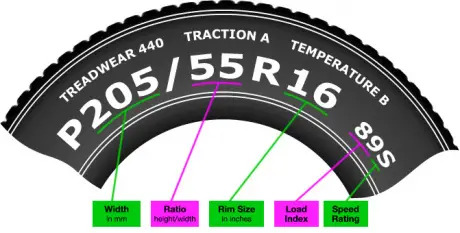
Have you ever noticed that there are lots of complex symbols and numbers on the sidewall of a tire? They are not just for decoration or design, but all figures and alphabets have a meaning. There is a plethora of data hidden behind those numbers. You will need this data to select the appropriate tire size for your vehicle.
But the question is, how to decode tire numbers? We will be explaining everything in this tire size guide.
What Does Tire Size Mean?
A long, complex series of numbers and alphabets branded on a tire's sidewall. This chain of numbers contains data about the speed range, load rating, and other dimensions. You can also call them specs.
You must understand that tire size is much more than just a physical dimension and contains much other helpful information. With a little practice and focus, you will be able to decode these numbers like an expert.
Decoding Tire Size Class?
To understand everything better, let's start from the top. Most tire sizes are in the form of a series of numbers and symbols etched on the sidewall of a tire. There might be a single alphabet or a combination of them. These symbols tell us if the tire should be used for carrying kids or hauling heavy loads.
For example, consider the string printed on the tire's sidewall as "P205/55R19 92HXL M+S."
The symbol P at the start of the example means P-Metric. If there is no P at the beginning, you can call it a European-Metric. Passenger cars and minivans use these tires.
If the number starts with LT, it indicates that these tires carry heavy loads with pickup trucks and SUVs.
ST at the start of the number is the symbol for special trailer service. These tires should be used on heavy trucks.
C symbol is for commercial vehicles like delivery trucks.
T at the beginning shows that the tire is for temporary use in the case of a flat tire.
Decoding Tire Size-Dimensions
In the example above, next to the P symbol, a set of 3 digits "205" represents the tire width in millimeters.
The 2 numbers "55" after the slash indicate the aspect ratio of the tire. It gives a measure of sidewall height with the tire width.
Next comes the symbol "R", which shows the internal construction of a tire. R means the tire has radial construction.
After the symbol last 2 digits, "19" shows the wheel's diameter in inches.
Decoding Tire Size-Load Index
You can find a combination of 2 digits and 1 symbol after the tire size string "92H." first 2 digits shows the tire's load capacity. A tire (European Metric) with a 92 load index can carry up to 1389 pounds. A tire with a higher index can carry more weight.
Decoding Tire Size-Speed Rating
H shows the speed Rating of the tire. It is a measure of the fastest speed the tire can handle.
Decoding Tire Size- Load Range
The XL in the last of the above example indicates the load range. XL is a symbol of the extra load. You can also call it reinforced load range.
Decoding Tire Size- Weather Rating
M+S means that the tire has a rating for mud and snow.
Same articles

Understanding Vehicle Inspection and Verification Services: Why They Matter for Every Driver
GuidesVehicle inspection and verification services are an essential but often overlooked part of keeping roads safe and cars legally compliant. Most people only think about inspections when it’s...
KLIFEX Brand Overview: High-Quality Automotive Repair Kits for Affordable Repairs
GuidesThe automotive aftermarket has long needed solutions that combine reliability, durability, and affordability. Many car enthusiasts and services are looking for a way...
Fast, Reliable Vehicle Emissions & Inspection Services Made Simple
GuidesFast, reliable emissions and inspection services are essential for keeping vehicles road-ready, compliant with environmental regulations, and safe for daily driving. If you’re looking for quick...

